Development, Application and Challenges of Set Pair Analysis in Environmental Science from 1989 to 2020: A Bibliometric Review
Abstract
:1. Introduction
2. Basic Concept of SPA
2.1. Connection Number
2.2. Partial Connection Number
3. Development and Application of SPA in Environmental Sciences
3.1. SPA Application and Development in Ecology
3.2. SPA Application and Development in Water Resource
3.3. SPA Application and Development in Atmospheric Environmental Sciences
4. Challenges of SPA in Environmental Sciences
5. Conclusions
Author Contributions
Funding
Institutional Review Board Statement
Informed Consent Statement
Data Availability Statement
Conflicts of Interest
References
- Su, F.; Li, P.; He, X.; Vetrimurugan, E. Set pair analysis in earth and environmental sciences: Development, challenges, and future prospects. Expo. Health 2020, 12, 343–354. [Google Scholar] [CrossRef]
- Chen, N.X.; Su, R.; Cao, W.G. Application of the set pair analysis method to evaluation of shallow groundwater quality based on entropy weight. J. Arid Land 2013, 27, 30–34. [Google Scholar]
- He, X.; Wu, J.; Guo, W. Karst spring protection for the sustainable and healthy living: The examples of Niangziguan Spring and Shuishentang Spring in Shanxi, China. Expo. Health 2019, 11, 153–165. [Google Scholar] [CrossRef]
- Gacko, I.; Muchova, Z.; Jurik, L.; Sinka, K.; Fabian, L.; Petrovic, F. Decision making methods to optimize new dam site selections on the Nitra River. Water 2020, 12, 2042. [Google Scholar] [CrossRef]
- Dogra, N.; Sharma, M.; Sharma, A.; Keshavarzi, A.; Minakshi; Bhardwaj, R.; Thukral, A.K.; Kumar, V. Pollution assessment and spatial distribution of roadside agricultural soils: A case study from India. Int. J. Environ. Health R 2020, 30, 146–159. [Google Scholar] [CrossRef]
- Ravar, Z.; Zahraie, B.; Sharifinejad, A.; Gozini, H.; Jafari, S. System dynamics modeling for assessment of water-food-energy resources security and nexus in Gavkhuni basin in Iran. Ecol. Indic. 2020, 108, 105682. [Google Scholar] [CrossRef]
- Chi, Y.X.; Xue, L.Q.; Zhang, H. Comprehensive benefit analysis of regional water resources based on multi-objective evaluation. In IOP Conference Series-Earth and Environmental Science; IOP: Chongqing, China, 2018; Volume 108. [Google Scholar]
- Liu, D.; Zhang, G.D.; Li, H.; Fu, Q.; Li, M.; Faiz, M.A.; Ali, S.; Li, T.X.; Khan, M.I. Projection pursuit evaluation model of a regional surface water environment based on an Ameliorative Moth-Flame Optimization algorithm. Ecol. Indic. 2019, 107. [Google Scholar] [CrossRef]
- Ikram, M.; Zhang, Q.Y.; Sroufe, R.; Shah, S.Z.A. Towards a sustainable environment: The nexus between ISO 14001, renewable energy consumption, access to electricity, agriculture and CO2 emissions in SAARC countries. Sustain. Prod. Consump. 2020, 22, 218–230. [Google Scholar] [CrossRef]
- Xiang, B.; Song, J.W.; Wang, X.Y.; Zhen, J. Improving the accuracy of estimation of eutrophication state index using a remote sensing data-driven method: A case study of Chaohu Lake, China. Water 2015, 41, 753–761. [Google Scholar] [CrossRef] [Green Version]
- Zhao, K.Q. Set Pair and Set Pair Analysis-A New Concept and A New Method of System Analysis; National Conference on System Theory and Regional Planning: Baotou, China, 1989. [Google Scholar]
- Cui, Y.; Feng, P.; Jin, J.L.; Liu, L. Water resources carrying capacity evaluation and diagnosis based on set pair analysis and improved the entropy weight method. Entropy 2018, 20, 359. [Google Scholar] [CrossRef] [Green Version]
- Wang, M.W.; Chen, G.Y.; Jin, J.L. Entropy-based of set pair analysis model for optimization of land consolidation plans. Trans. Chin. Soc. Agric. Eng. 2010, 26, 322–325. [Google Scholar]
- Wu, C.G.; Wang, Y.M.; Jin, J.L.; Wei, Y.M.; Huang, Q. Set Pair Analysis and BP Neural Network Coupling Model for Optimal Selection of Flood Control Operation. In Proceedings of the 2010 Chinese Control and Decision Conference, Xuzhou, China, 26 May–28 August 2010. [Google Scholar]
- Wang, W.S.; Jin, J.L.; Ding, J.; Li, Y.Q. A new approach to water resources system assessment-set pair analysis method. Sci. China Ser. E Technol. Sci. 2009, 52, 3017–3023. [Google Scholar] [CrossRef]
- Pan, Z.W.; Wu, K.Y.; Jin, J.L.; Liu, X.W. Assessment Model of Set Pair Analysis for Flood Loss Based on Triangular Fuzzy Intervals Under Alpha-Cut. In Proceedings of the 21st Chinese Control and Decision Conference, Guilin, China, 17–19 June 2009. [Google Scholar]
- Jin, J.L.; Cheng, L.; Li, Y.Q.; Wang, W.S. Fuzzy Clustering Method Based on Set Pair Analysis and Optimal Fuzzy Equivalent Matrix for Flood Classification. In Proceedings of the 21st Chinese Control and Decision Conference, Guilin, China, 17–19 June 2009. [Google Scholar]
- Wang, W.S.; Li, Y.Q.; Jin, J.L. Relation analysis of hydrological variables based on set pair principle. J. Sichuan Univ. 2009, 41, 1–5. [Google Scholar]
- Xie, Y.X.; Wang, W.S. Risk Degree Assessment of Natural Disasters in China Using Set Pair Analysis Method. In Proceedings of the 1st International Conference on Energy and Environmental Protection, Hohhot, China, 23–24 June 2012. [Google Scholar]
- Wang, W.S.; Li, Y.Q. Hazard degree assessment of landslide using set pair analysis method. Nat. Hazards 2012, 60, 367–379. [Google Scholar]
- Zhao, K.Q. Set Pair Analysis and Its Preliminary Application; Zhejiang Science and Technology Press: Zhejiang, China, 2000. [Google Scholar]
- Zhao, K.Q. Partial Connection Number; Progress of Artificial Intelligence in China: Beijing, China, 2005. [Google Scholar]
- Shen, Z.Y.; Zhang, Z.; Xie, T.F. Application of set pair analysis in environmental quality assessment. Environ. Prot. 1999, 10, 3–5. [Google Scholar]
- Zhang, W.Y.; Fang, H.; Cai, J.A.; Zhong, M.Y. Assessment for air environmental quality of Ma’anshan City by set pair analysis method. J. Nanjing Univ. Sci. Technol. 2003, 27, 426–430. [Google Scholar]
- Deng, H.X.; Li, C.J.; Zhu, B.; Ding, J. Integrative assessment of eco-carrying capacity based on set pair analysis. J. Yangtze River Sci. Res. Inst. 2006, 23, 35–38. [Google Scholar]
- Hu, X.X.; Yang, X.H.; Li, J.Q.; Geng, L.H. Set pair analysis model for river health system assessment. Syst. Eng. Theory Pract. 2008, 28, 164–170, 176. [Google Scholar]
- Meng, X.M.; Hu, H.P. Application of set pair analysis model based on entropy weight to comprehensive evaluation of water quality. J. Hydraul. Eng. 2009, 40, 257–262. [Google Scholar]
- Su, M.R.; Yang, Z.F.; Chen, B. Set pair analysis for urban ecosystem health assessment. Commun. Nonlinear Sci. 2009, 14, 1773–1780. [Google Scholar] [CrossRef]
- Su, M.R.; Yang, Z.F.; Chen, B.; Ulgiati, S. Urban ecosystem health assessment based on emergy and set pair analysis-A comparative study of typical Chinese cities. Ecol. Model. 2009, 220, 2341–2348. [Google Scholar] [CrossRef]
- Su, M.R.; Yang, Z.F.; Chen, B. Urban ecosystem health assessment based on vitality index and set pair analysis. China Popul. Resour. Environ. 2010, 20, 122–128. [Google Scholar]
- Li, T.; Fu, Q.; Ding, H. Application of projection pursuit based set pair analysis model in the evaluation of underground water quality. J. Northeast. Agric. Univ. 2010, 41, 48–52. [Google Scholar]
- Yao, Z.H.; Wang, H.Q.; Hao, X.G. Evaluation of geological environment carrying capacity based on set pair analysis: A case study in Daqing. Environ. Sci. Technol. 2010, 33, 183–189. [Google Scholar]
- Li, W.J.; Qiu, L.; Chen, X.N.; Huang, Q. Assessment model for river ecology health based on set pair analysis and variable fuzzy set. J. Hydraul. Eng. 2011, 42, 775–782. [Google Scholar]
- Han, R.L.; Tong, L.J.; Tong, W.M.; Yu, J.H. Research on vulnerability assessment of human-land system of Anshan city based on set pair analysis. Prog. Geogr. 2012, 31, 344–352. [Google Scholar]
- Li, J.J.; Shan, H.X.; Pan, Y.Y.; Wen, J.J.; Wu, D. Urban contaminated sites risk classification based on the analytic hierarchy process and set pair analysis. Environ. Eng. 2013, 31, 89–94. [Google Scholar]
- Wang, H.Q.; Tian, Y.N.; Sun, J.W.; Zhang, Y.F. Resource and environmental carrying capacity based on set pair analysis in inner mongolia. J. Beijing Norm. Univ. 2013, 49, 292–296. [Google Scholar]
- Zhao, X.L.; Qi, Q.J.; Zhao, G.Z.; Wang, E.L.; Zhang, X. Establishment and application of set pair analysis model for a three-dimensional quantitative evaluation of coal mining environment. J. Arid. Land Resour. Environ. 2014, 28, 72–77. [Google Scholar]
- Wu, C.G.; Wang, Y.M.; Tang, Y.M.; Huang, Q.; Jin, J.L. Variable fuzzy recognition model for the flood hazard assessment based on set pair analysis. J. Northwest A F Univ. 2012, 40, 221–226. [Google Scholar]
- Yang, F.G.; Liang, Y.; Singh, V.P.; Wang, W.S.; Zhou, X.Q.; Liu, X.N.; Cao, S.Y.; Huang, E.; Wu, Y.H. Debris flow hazard assessment using set pair analysis models: Take Beichuan county as an example. J. Mt. Sci. 2014, 11, 1015–1022. [Google Scholar] [CrossRef]
- Guo, E.L.; Zhang, J.Q.; Ren, X.H.; Zhang, Q.; Sun, Z.Y. Integrated risk assessment of flood disaster based on improved set pair analysis and the variable fuzzy set theory in central Liaoning Province, China. Nat. Hazards 2014, 74, 947–965. [Google Scholar] [CrossRef]
- Su, Y.F.; Cheng, H.H.; Yu, Y.J.; Sun, X.X.; Bao, L.Y. Evaluation model of early warning for pollution emission reduction management based on set pair analysis method and improved application. Trans. Beijing Inst. Technol. 2015, 35, 203–207. [Google Scholar]
- Huang, X.; Guan, Z.Y.; Wang, Q.; Qiu, L. Application of refined set pair analysis to comprehensive evaluation of lake water quality. Water Resour. Hydropower Eng. 2012, 43, 35–37. [Google Scholar]
- Guo, X.J.; Zhou, J.L.; Guo, L.; Wang, Y.P. Application of the set pair analysis based on entropy weight to assessment of groundwater quality in Tarim basin. Geotech. Investig. Surv. 2012, 40, 56–59. [Google Scholar]
- Zheng, Z.H.; Wei, M.H. Water quality fuzzy evaluation based on entropy method-improved set pair analysis. J. Hohai Univ. 2013, 41, 136–139. [Google Scholar]
- Zhou, Y.Z.; Gao, M.T. An improved fuzzy-set pair analysis in water quality evaluation. Chin. J. Environ. Eng. 2015, 9, 749–755. [Google Scholar]
- Xu, Y.W.; Li, Z.Y.; Wang, J.Y. Study on the similar forecast models of precipitation acidity and water quality based on set pair analysis. Environ. Pollut. Control. 2015, 37, 59–62, 88. [Google Scholar]
- Zhang, Y.C.; Wang, L.; Xiong, X.; Shi, L.H. Evaluation of typhoon disaster prevention and mitigation ability in Fujian Province based on set pair analysis. J. Catastrophol. 2015, 30, 85–88. [Google Scholar]
- Gao, S.D.; Fang, D.X.; Pan, Z.W. Research on comprehensive index assessment model of river water quality based on set pair analysis theory. J. Hefei Univ. Technol. 2015, 38, 654–658. [Google Scholar]
- Ren, Y.Q.; Zheng, J.H.; Dong, H. A comprehensive evaluation model of fishing vessel safety based on set pair analysis. J. Navig. China 2012, 35, 60–63, 75. [Google Scholar]
- Shi, K.F.; Diao, C.T.; Sun, X.F.; Zuo, T.A.; Cai, Z.; Yu, Y.C. Evaluation of eco-security of cultivated land requisition-compensation balance based on improved set pair analysis. Acta Ecol. Sin. 2013, 33, 1317–1325. [Google Scholar]
- Wang, Y.; Shao, L.; Yang, F.T.; Zhou, X.D. Comprehensive evaluation method of water quality based on improved set pair analysis. J. Hydroelectr. Eng. 2012, 31, 99–106. [Google Scholar]
- Zou, Q.; Zhou, J.Z.; Zhou, C.; Song, L.X.; Guo, J. Comprehensive flood risk assessment based on set pair analysis-variable fuzzy sets model and fuzzy AHP. Stoch. Environ. Res. Risk Assess. 2013, 27, 525–546. [Google Scholar] [CrossRef]
- Wei, C.X.; Dai, Y.; Ye, S.F.; Guo, Z.Y.; Wu, J.P. Prediction analysis model of integrated carrying capacity using set pair analysis. Ocean. Coast Manag. 2016, 120, 39–48. [Google Scholar] [CrossRef]
- Li, C.H.; Sun, L.; Jia, J.X.; Cai, Y.P.; Wang, X. Risk assessment of water pollution sources based on an integrated k-means clustering and set pair analysis method in the region of Shiyan, China. Sci. Total Environ. 2016, 557, 307–316. [Google Scholar] [CrossRef] [PubMed]
- Yan, F.; Xu, K.L. Application of a cloud model-set pair analysis in Hazard Assessment for biomass gasification stations. PLoS ONE 2017, 12, e0170012. [Google Scholar] [CrossRef] [Green Version]
- Luan, W.F.; Lu, L.; Li, X.; Ma, C.F. Integrating extended fourier amplitude sensitivity test and set pair analysis for sustainable development evaluation from the view of uncertainty analysis. Sustainability 2018, 10, 2435. [Google Scholar] [CrossRef] [Green Version]
- Liu, Y.C.; Wang, C.S.; Chun, Y.T.; Yang, L.X.; Chen, W.; Ding, J. A novel method in surface water quality assessment based on improved variable fuzzy set pair analysis. Int. J. Environ. Res. Public Health 2019, 16, 4314. [Google Scholar] [CrossRef] [PubMed] [Green Version]
- Tao, M.A.; Chi, D.C.; Wang, D.W.; Shi, L.Z.; Wu, Q. Evaluation of sustainable development for irrigation district based on set pair analysis. J. Shenyang Agric. Univ. 2007, 38, 841–844. [Google Scholar]
- Wang, H.W.; Zhang, X.; Qiu, J.N. Application of fuzzy set pair analysis method in safety evaluation of water resources. J. Northwest A F Univ. 2011, 39, 209–214. [Google Scholar]
- Li, P.Y.; Qian, H.; Wu, J.H. Application of set pair analysis method based on entropy weight in groundwater quality assessment—A case study in Dongsheng city, northwest China. E-J. Chem. 2011, 8, 851–858. [Google Scholar]
- Jin, J.L.; Wei, Y.M.; Zou, L.L.; Liu, L.; Zhang, W.W.; Zhou, Y.L. Forewarning of sustainable utilization of regional water resources: A model based on BP neural network and set pair analysis. Nat. Hazards 2012, 62, 115–127. [Google Scholar] [CrossRef]
- Chou, C.M. Application of set pair analysis-based similarity forecast model and wavelet denoising for runoff forecasting. Water 2014, 6, 912–928. [Google Scholar] [CrossRef] [Green Version]
- Yue, W.C.; Cai, Y.P.; Rong, Q.Q.; Li, C.H.; Ren, L.J. A hybrid life-cycle and fuzzy-set-pair analyses approach for comprehensively evaluating impacts of industrial wastewater under uncertainty. J. Clean Prod. 2014, 80, 57–68. [Google Scholar] [CrossRef]
- Liu, T.; Yang, X.H.; Song, F. Comprehensive evaluation for water resources carrying capacity in Jilin province based on fuzzy set pair analysis model. Water Resour. Ecol. Carr. Capacit. 2018, 8–15. [Google Scholar]
- Zhang, X.Y.; Du, X.F.; Li, Y.B. Comprehensive evaluation of water resources carrying capacity in ecological irrigation districts based on fuzzy set pair analysis. Desalination Water Treat. 2020, 187, 63–69. [Google Scholar] [CrossRef]
- Guo, Y.H.; Shao, D.G.; Liu, Y.L.; Chen, S. Establishment and application of set pair analysis model based on game theory for post-assessment of project construction effectiveness. Trans. Chin. Soc. Agric. Eng. 2015, 31, 5–12. [Google Scholar]
- Li, B.; Wu, Q.; Duan, X.Q.; Chen, M.Y. Risk analysis model of water inrush through the seam floor based on set pair analysis. Mine Water Environ. 2018, 37, 281–287. [Google Scholar]
- Men, B.H.; Liu, H.L. Evaluation of sustainable use of water resources in the Beijing-Tianjin-Hebei region based on S-Type functions and set pair analysis. Water 2018, 10, 925. [Google Scholar] [CrossRef] [Green Version]
- Tian, R.; Wu, J.H. Groundwater quality appraisal by improved set pair analysis with game theory weightage and health risk estimation of contaminants for Xuecha drinking water source in a loess area in Northwest China. Hum. Ecol. Risk Assess. 2019, 25, 132–157. [Google Scholar] [CrossRef]
- Su, F.M.; Wu, J.H.; He, S. Set pair analysis-Markov chain model for groundwater quality assessment and prediction: A case study of Xi’an city, China. Hum. Ecol. Risk Assess. 2019, 25, 158–175. [Google Scholar] [CrossRef]
- Wu, M.M.; Ge, W.; Li, Z.K.; Wu, Z.N.; Zhang, H.X.; Li, J.J.; Pan, Y.P. Improved set pair analysis and its application to environmental impact evaluation of dam break. Water 2019, 11, 821. [Google Scholar] [CrossRef] [Green Version]
- Yin, J.; Tsai, F.T.C. Bayesian set pair analysis and machine learning based ensemble surrogates for optimal multi-aquifer system remediation design. J. Hydrol. 2020, 580, 124280. [Google Scholar] [CrossRef]
- Li, F.X.; Chen, W. Optimal setting of environmental monitoring sites by the fuzzy set pair analysis way. Environ. Prot. Sci. 2001, 27, 30–32. [Google Scholar]
- Xue, G.Y.; Wang, G.Q. The application research of the theory of uncertainty-set pair analysis in establishment of weather forcast models. Acta Meteorol. Sin. 2003, 61, 592–599. [Google Scholar]
- Xu, M.L. Application of set pair analysis to Yunnan heavy precipitation processes forecast ensemble. Meteorol. Mon. 2004, 30, 39–42. [Google Scholar]
- Wang, F.Q.; Guo, D.M. Application of uncertainty-set pair analysis for sandstorm forecast in northwest of China. J. Desert Res. 2006, 26, 268–272. [Google Scholar]
- Zhang, Y.; Yang, X.H.; Zhang, L.; Ma, W.Y.; Qiao, L.X. Set pair analysis based on phase space reconstruction model and its application in forecasting extreme temperature. Math. Probl. Eng. 2013, 2013, 516150. [Google Scholar] [CrossRef]
- Wang, M.W.; Xu, P.; Li, J.; Zhao, K.Y. A novel set pair analysis method based on variable weights for liquefaction evaluation. Nat. Hazards 2014, 70, 1527–1534. [Google Scholar] [CrossRef]
- Zhang, J.; Yang, X.H.; Li, Y.Q. A refined rank set pair analysis model based on wavelet analysis for predicting temperature series. Int. J. Numer. Methods Heat Fluid Flow 2015, 25, 974–985. [Google Scholar] [CrossRef]
- Wang, D.; Borthwick, A.G.; He, H.D.; Wang, Y.K.; Zhu, J.Y.; Lu, Y.; Xu, P.C.; Zeng, X.K.; Wu, J.C.; Wang, L.C.; et al. A hybrid wavelet de-noising and Rank-Set Pair Analysis approach for forecasting hydro-meteorological time series. Environ. Res. 2018, 160, 269–281. [Google Scholar] [CrossRef] [PubMed] [Green Version]
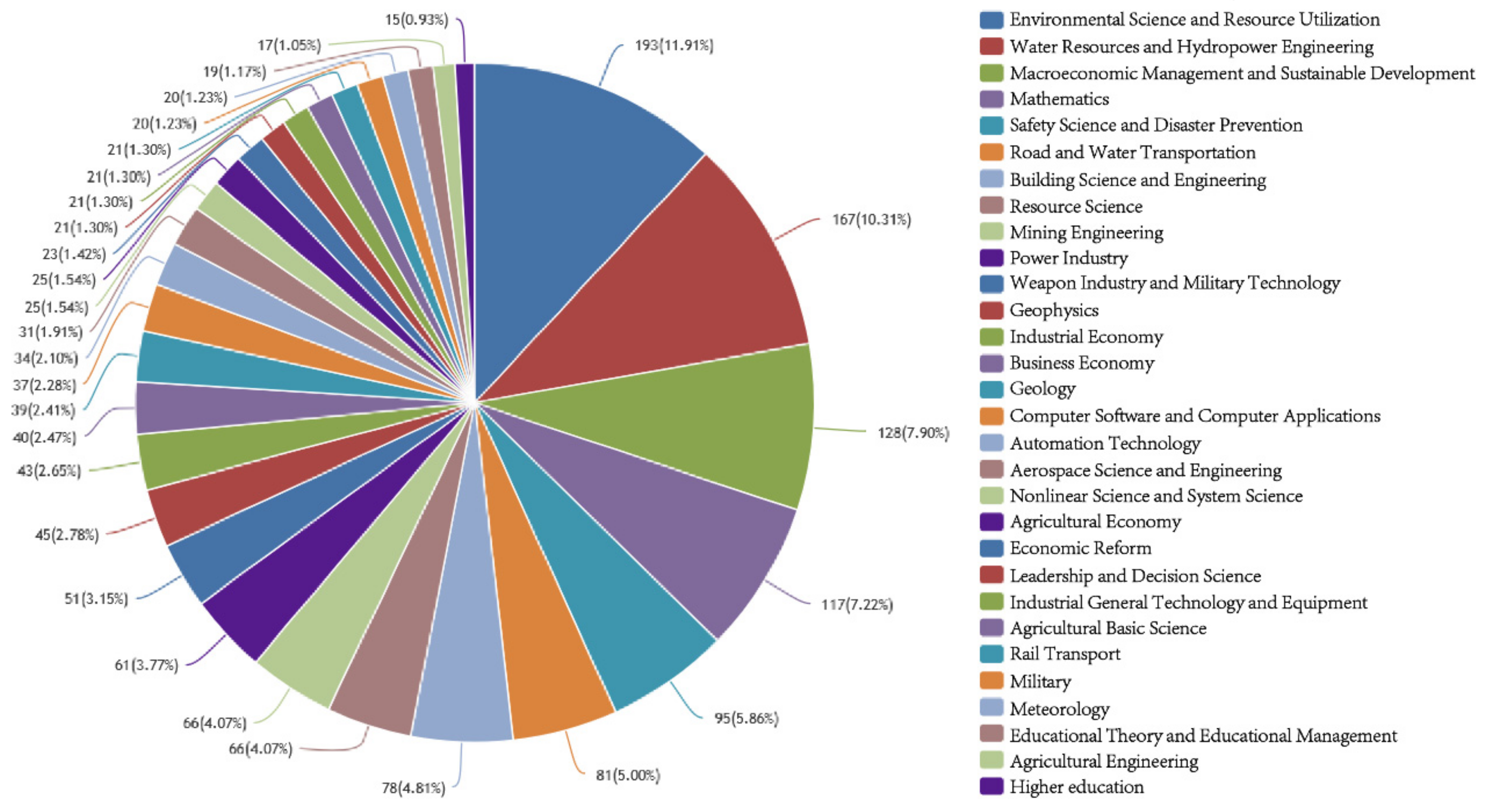
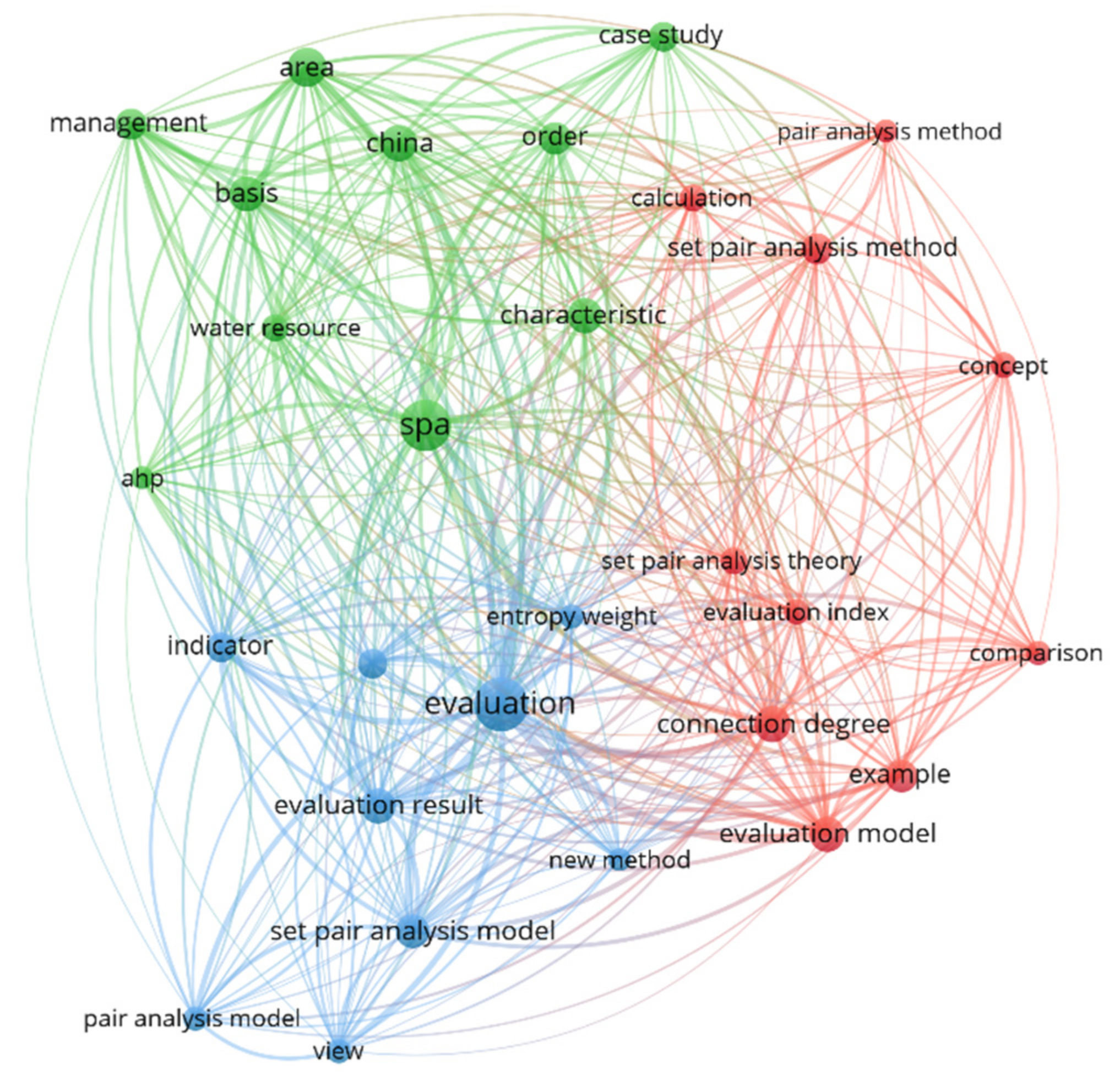
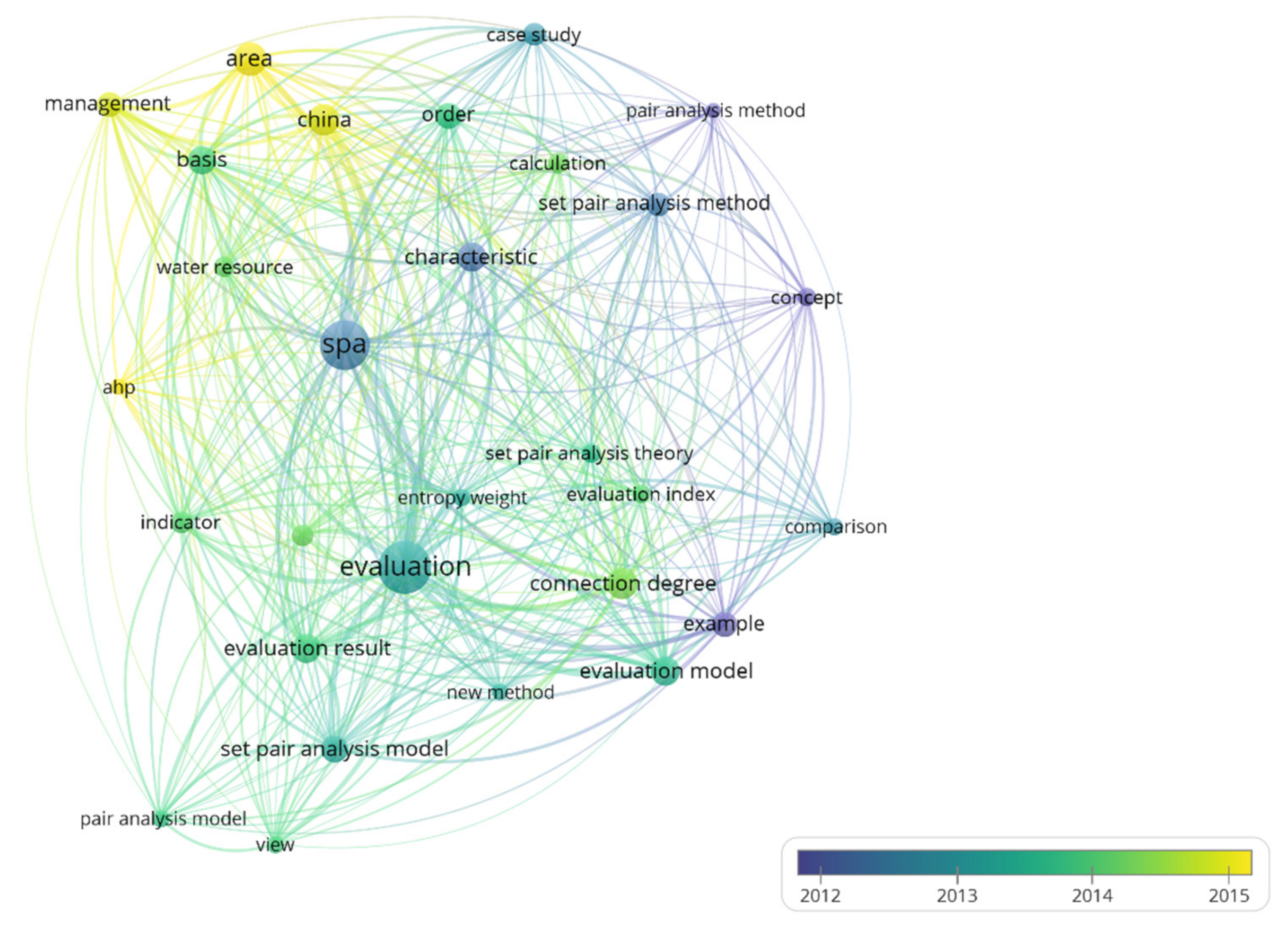
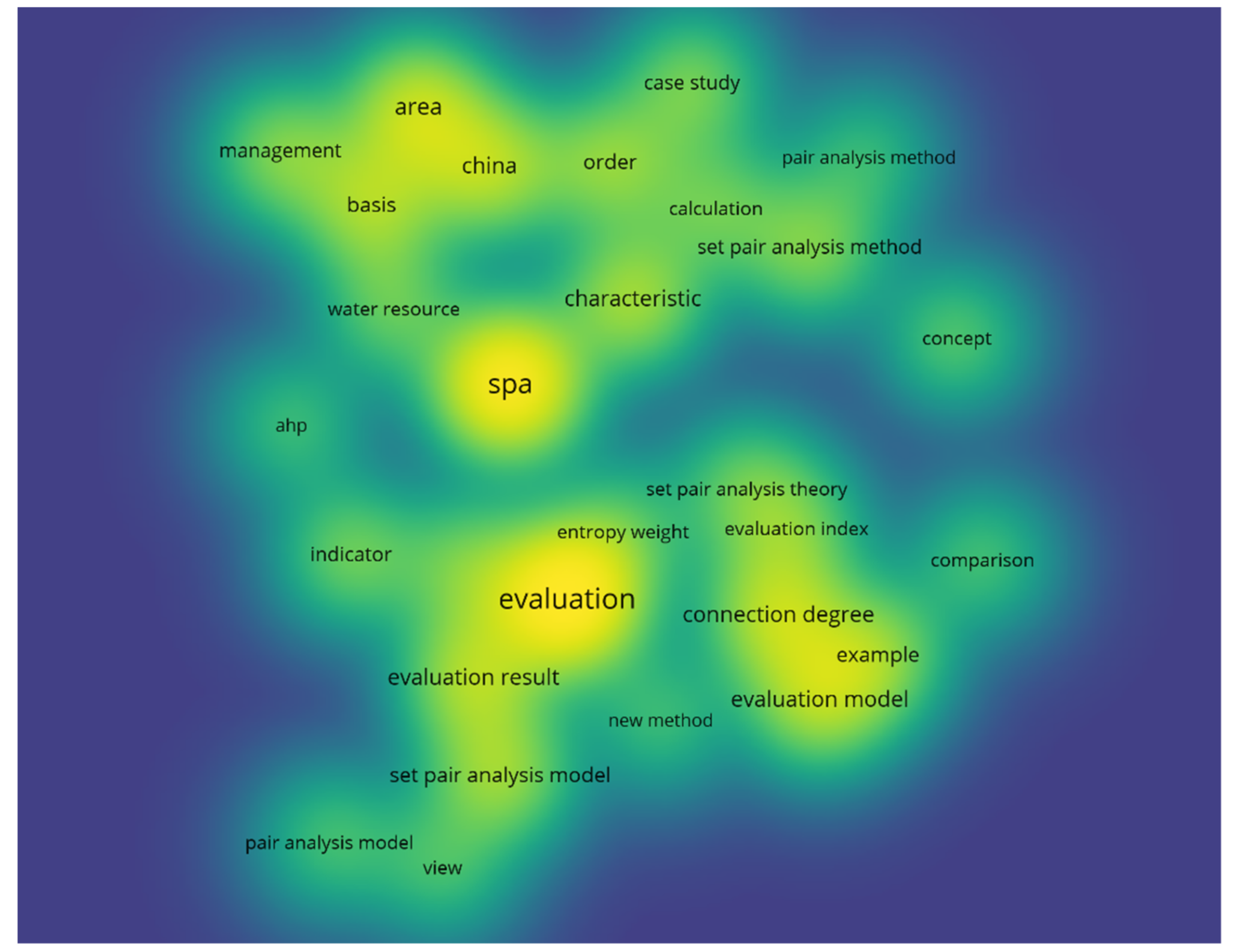
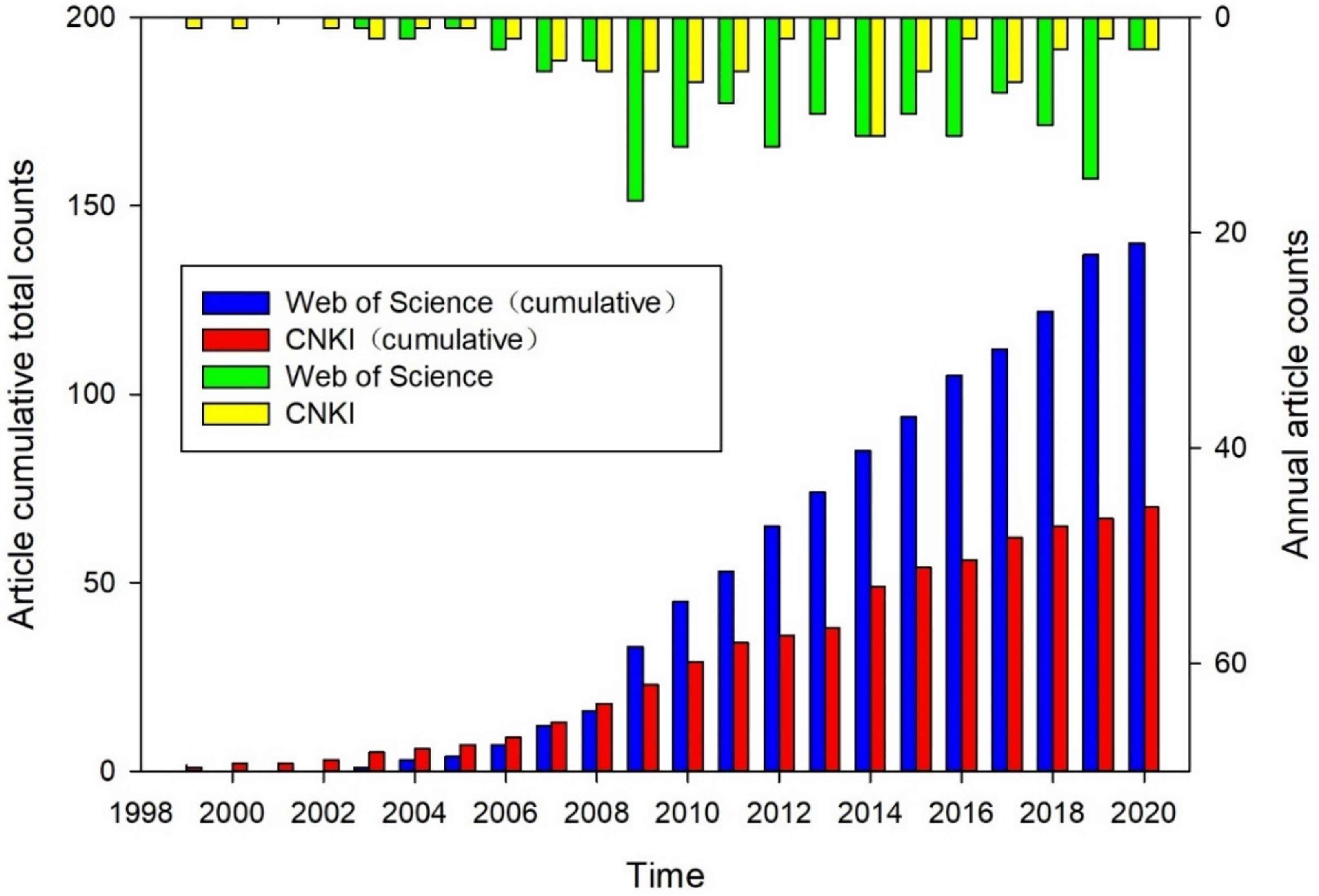
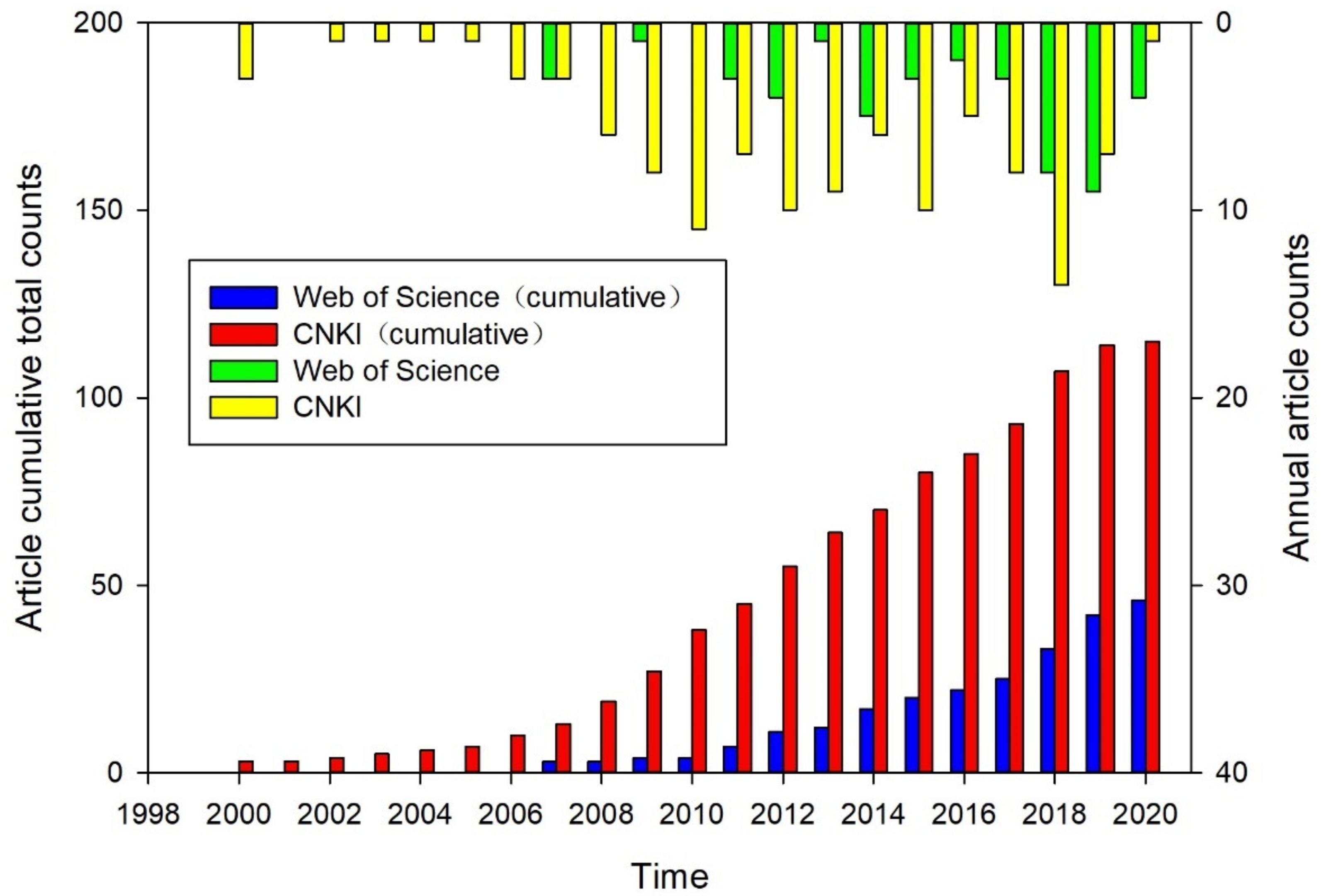
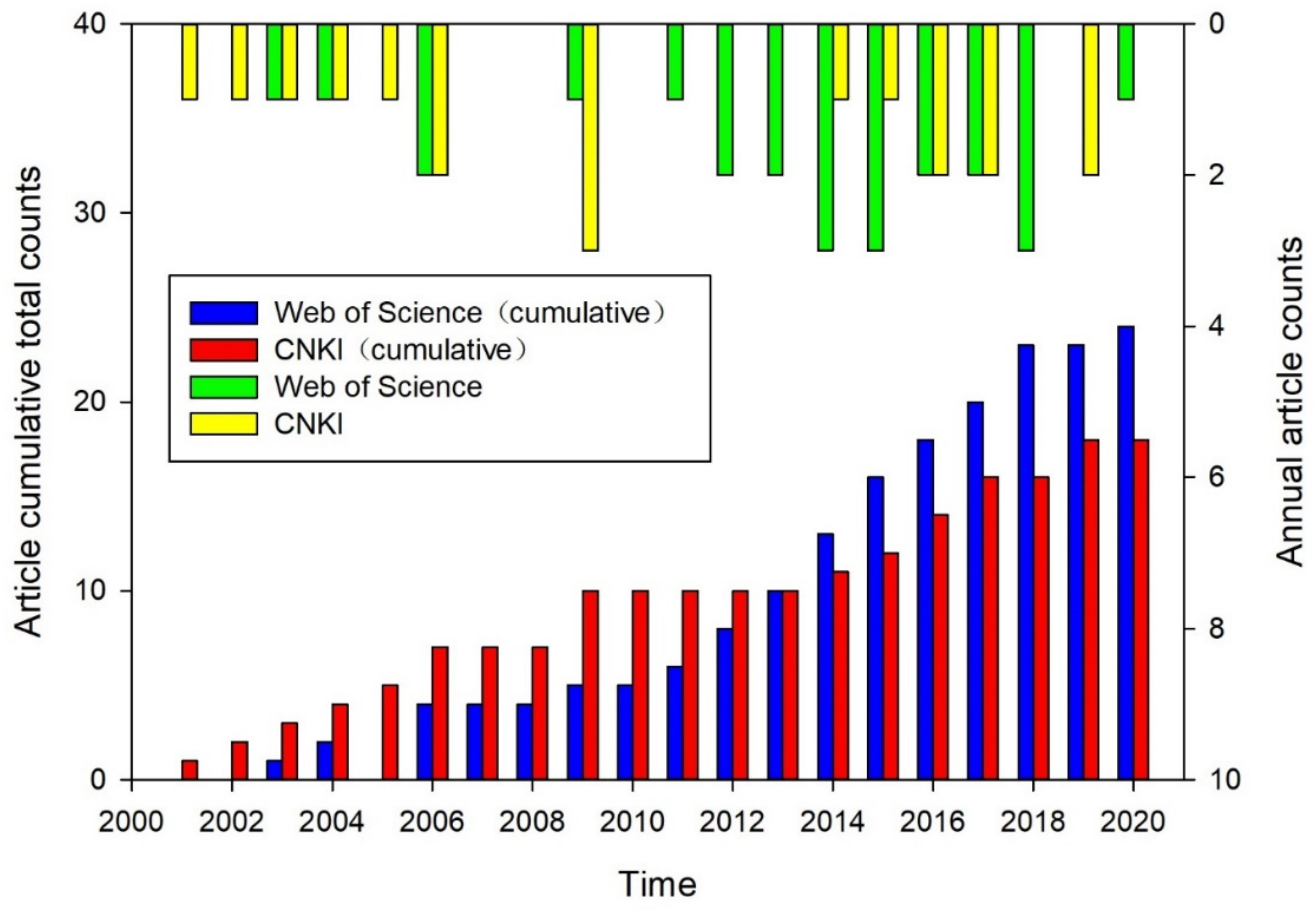

Publisher’s Note: MDPI stays neutral with regard to jurisdictional claims in published maps and institutional affiliations. |
© 2021 by the authors. Licensee MDPI, Basel, Switzerland. This article is an open access article distributed under the terms and conditions of the Creative Commons Attribution (CC BY) license (https://creativecommons.org/licenses/by/4.0/).
Share and Cite
Xiang, W.; Yang, X.; Babuna, P.; Bian, D. Development, Application and Challenges of Set Pair Analysis in Environmental Science from 1989 to 2020: A Bibliometric Review. Sustainability 2022, 14, 153. https://doi.org/10.3390/su14010153
Xiang W, Yang X, Babuna P, Bian D. Development, Application and Challenges of Set Pair Analysis in Environmental Science from 1989 to 2020: A Bibliometric Review. Sustainability. 2022; 14(1):153. https://doi.org/10.3390/su14010153
Chicago/Turabian StyleXiang, Weiqi, Xiaohua Yang, Pius Babuna, and Dehui Bian. 2022. "Development, Application and Challenges of Set Pair Analysis in Environmental Science from 1989 to 2020: A Bibliometric Review" Sustainability 14, no. 1: 153. https://doi.org/10.3390/su14010153
APA StyleXiang, W., Yang, X., Babuna, P., & Bian, D. (2022). Development, Application and Challenges of Set Pair Analysis in Environmental Science from 1989 to 2020: A Bibliometric Review. Sustainability, 14(1), 153. https://doi.org/10.3390/su14010153








